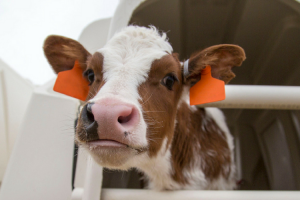A new look at livestock bugs we can’t kill
2017-09-04
When we talk about the balancing act of a healthy gastrointestinal tract, we want to make sure that calories, colostrum, cleanliness, comfort, the strength of the immune system and the health of the gut flora outweigh the pathogens that may invade the gastrointestinal tract of calves. In a recent webinar, Dr. Corale Dorn, a veterinarian at Dells Veterinary Services in Dell Rapids, South Dakota, explained how using proper management practices and keeping an eye out for diseases are key to tipping the scales in the right direction for healthy calves.

Calories
We need to adjust our thinking from quarts to the number of calories that calves are receiving through milk replacer.
“When I go out to a farm in the dead of winter in South Dakota and they are only feeding 2 quarts of 20/20 milk replacer every 12 hours, I know we are not hitting anywhere near the calorie requirements that we need,” said Dorn. “If we are completely missing the mark on these calorie requirements, we cannot expect to maintain calf health when pathogens enter the herd.”
If we are getting 2.1–2.5 pounds of average daily gain on Holstein calves, then we have enough calories to keep the calves healthy and growing.
The calories and protein that they need depend on their weight and the temperature of their environment. For example, during the winter in South Dakota, we need to be feeding at least 6 quarts of milk a day. This can be pasteurized whole milk or 24/20 milk replacer.
Re-evaluating our thinking when it comes to feeding calves for the calories they need can assist in their ability to endure seasonal changes and other challenges that can impact calf health.
Colostrum
It’s a given that calves need a good measure of colostrum beginning at calving. We know that when we take a blood sample at 24–48 hours post-calving, calves well-fed with colostrum should reach a calibrated total protein of 6.0 grams per deciliter
For calves that require esophageal tubes, we need to make sure they are getting 1 gallon of colostrum within the first six hours of life.
Not only is quantity key, but quality is equally important. Colostrum needs to be clean, high in immunoglobulin (IgG), low in bacteria and fed as soon possible. If colostrum is not fed within one hour, it needs to be cooled to less than 35 degrees Fahrenheit to prevent bacterial growth.
Cleanliness
A standard procedure to ensure milk bottles and nipples are properly cleaned is extremely important to reduce pathogen exposure to calves. It is also vital that the environment the calf comes into is managed properly to ensure cleanliness.
“The maternity pen is the first place the calf is going to be, so ask yourself, can you kneel into the bedding and come out with dry knees?” asked Dorn. “If you have a large surge in calving, you can have a very dirty pen, so ensuring that pen is cleaned as frequently as necessary is important.”
Calves should be moved to a clean “wet calf” area within the first 15 minutes of life before attempting to stand. Be sure to clean this area vigorously after every calf to prevent pathogens from spreading between calves.
Comfort
The thermo-neutral zone for a calf is 50–68 degrees Fahrenheit.
In the winter, use calf jackets and deep bedding.
In the summer, we start to get anxious when we have semi-opaque housing, as on hot days these hutches can get very hot if not ventilated properly. Looking at ways to provide additional ventilation and water to hutch calves during the summer months is key to keeping calves cool and comfortable.
Immune system
Everything we do impacts the health of the immune system. Normally, when bacteria invade the calf’s system, immune cells attack and swallow up the bad bacteria, destroying them. However, some bad bacteria can evade this immune response.
“The problem with some of the bugs that enter the immune system, such as Salmonella, is that they have developed ways to invade the calf’s immune system by hitching a ride on the white blood cells,” explained Dorn. “Once bacteria join ranks with the white blood cells, we have a breach in the immune system and have bugs we can’t kill, with few medicines or vaccines that can slow down this process. This is where MOS products come into play. When bacteria attempt to attach to receptors on the intestinal wall, MOS blocks the attachment of these bacteria.”
Stop bugs before they take hold in your livestock
Long gone are the days we could just give calves a drug and kill the bug. Dorn advised dairy producers to:
- Keep the maternity pen clean. Be sure to test the bedding regularly to ensure it is not too damp.
- Ensure calves are well-fed! Remember, calves need an adequate supply of energy not only to fuel metabolic activity, but to support their developing immune system.
- Alltech’s Bio-Mos® is designed to feed the gastrointestinal tract and is the original solution to intestinal health issues. It promotes good bacteria and builds defenses, thereby maximizing performance and profitability.
To watch the full webinar, click here. For more information on how Bio-Mos might be a fit for your farm, visit bio-mos.com.


